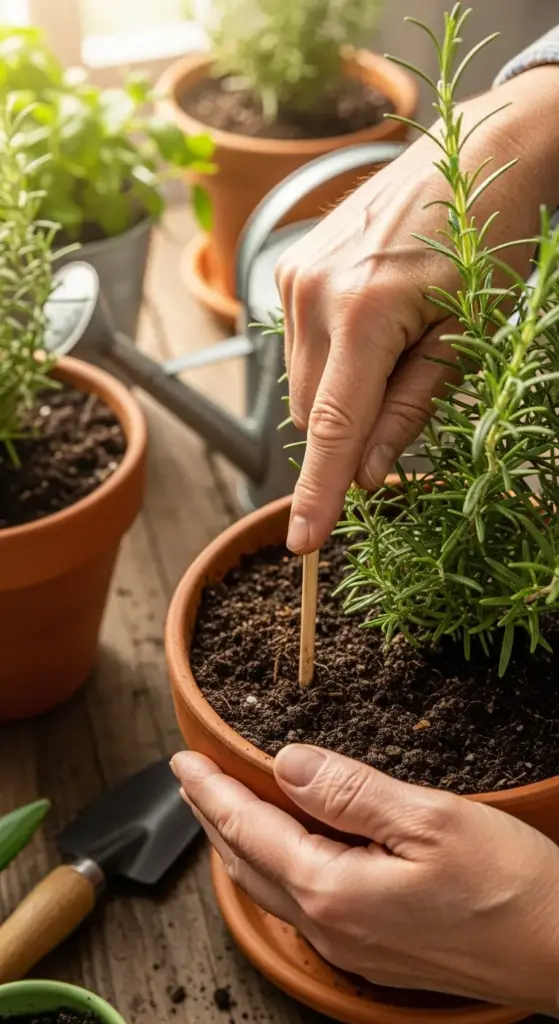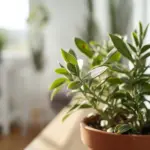2. The Ancient Watering Rhythm Technique

I used to be one of those people who watered my plants every single day like clockwork. Guess what? I was basically drowning my rosemary in good intentions.
It wasn’t until I met an old Italian gardener at a farmers market that I learned the truth. He looked at my sad, yellowing rosemary and chuckled: “You water like it’s a tomato plant, no?”
The Counterintuitive Schedule That Saves Lives
Here’s what blew my mind – rosemary actually prefers to dry out completely between waterings. We’re talking bone dry, desert-level dry.
Most herb guides tell you to keep soil “slightly moist.” That’s plant murder advice right there.
I now water my rosemary maybe once every 7-10 days in summer, and sometimes only twice a month in winter. Sounds crazy, right?
Reading Your Plant’s Secret Thirst Signals
After years of trial and error, I’ve learned that rosemary literally tells you when it’s thirsty. You just have to know the language.
Early thirst signals:
- Leaves feel slightly less firm when you pinch them
- The soil pulls away from pot edges slightly
- New growth tips look a tiny bit droopy (not the whole plant!)
Danger signals (you’ve waited too long):
- Leaves start turning grayish
- Stems feel woody and brittle
- The whole plant looks stressed and wilted
The sweet spot is catching it right at those early signals. This timing makes all the difference between thriving plants and struggling ones.
The Finger Test That Beats Every Gadget
Forget those fancy moisture meters – I’ve tried three different brands and they all lied to me. Your finger is way more accurate.
Here’s my exact method: stick your index finger straight down into the soil, all the way to your second knuckle. If you feel ANY moisture at that depth, don’t water yet.
For container rosemary, I actually lift the pot too. A dry pot feels surprisingly light compared to a watered one. You’ll learn this weight difference after a few cycles.
Seasonal Adjustments That Most People Miss
This is where I made my biggest mistakes early on. I was watering the same amount year-round like an amateur.
Summer watering (outdoor plants):
- Check every 3-4 days
- Water deeply but less frequently
- Early morning is crucial (more on this below)
Winter watering (indoor plants):
- Check every 10-14 days
- Reduce water amount by about 50%
- Plants basically go dormant and need way less
I learned this the hard way when I killed two beautiful rosemary plants by overwatering them in December. They just sat there in wet soil for weeks.
The Morning vs Evening Game-Changer
Okay, this one’s going to sound weird, but morning watering literally changed my rosemary game. I used to water in the evenings because it was convenient after work.
Big mistake. Here’s why morning watering works better:
The plant has all day to absorb what it needs and dry out excess moisture. Evening watering means the plant sits in dampness all night, which invites fungal problems.
I noticed way fewer issues with powdery mildew and root rot once I switched to morning watering. Plus, the plants seem more vibrant overall.
The Deep Soak Method
When I do water, I don’t mess around with light sprinkling. Rosemary wants a good drink, then a long dry period.
I water slowly until I see water coming out the drainage holes. Then I wait about 10 minutes and water again until it runs out again.
This ensures the water reaches all the roots, not just the top layer of soil. Shallow watering creates weak, surface-level root systems.
Indoor vs Outdoor Watering Differences
Indoor rosemary needs way less water than you think. The air circulation is different, humidity levels vary, and there’s no natural rainfall to account for.
I check my indoor plants weekly but usually only water every 10-12 days. The key is consistency in checking, not consistency in watering.
Outdoor plants in containers dry out faster due to wind and sun exposure. But they also get natural humidity from dew and occasional rain, so you have to factor that in.
My Biggest Watering Mistake (Don’t Do This)
I once went on vacation and asked my neighbor to water my plants. Came back to find she’d been watering my rosemary every other day “to be safe.”
Three of my best plants were goners. Root rot had set in so badly that the roots were literally black and mushy. It was heartbreaking.
Now I always leave specific instructions: “Only water if the soil is completely dry AND the plant looks slightly droopy.”
Think you’ve got watering figured out? Wait until you discover how the wrong pruning technique can actually reduce your harvest by 60%! Click “next” to learn The Pruning Power Secret for Maximum Harvest – this ancient method will transform your scraggly rosemary into a bushy, productive powerhouse.









GIPHY App Key not set. Please check settings